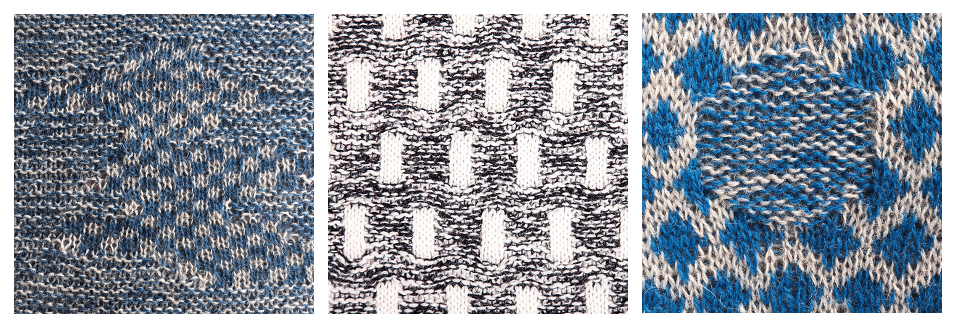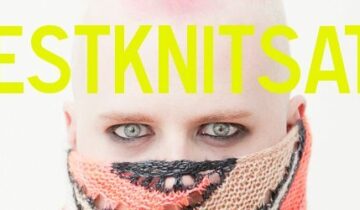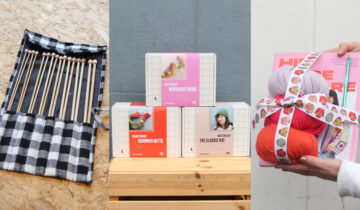As you all know, we are really excited to welcome artist and knitwear designer, Anna Maltz, at YAK on the 26th of November!
For those who won’t be able to attend her workshops, remember we are also hosting a party from 6:00 to 8:00 pm when you can meet Anna, have a look at all the samples from Penguin A Knit Collection and get your book signed. Penguin A Knit Collection offers a playful approach of knitting while completely immersing the reader into Anna’s colourful world. Not only the patterns are great, but the book is full of good tips, photos, drawing and tales on the inspirations behind her designs. It’s instructive, inspiring and fun, basically a great reading for every knitter.
Considering how quickly her workshops sold out, we thought there would be many of you as eager as we are to learn a bit more about her background. So here is Anna for you, who as kindly accepted to answer our question in a short interview.
From learning how to knit to publishing your first book, what was your personal creative journey like?
There are a good 30 years between when I learned how to knit from my mum, Oma and assorted other friends and family to when I published my first book of knitting patterns. During those years I have knitted all sorts of things from scarves, gloves and dresses to superheroes, invisible rabbits and nudes. I still find new things to knit, experiment with and keep me entertained. Writing and sharing patterns has been one of those new things for me to learn – part of my own education. Publishing patterns feels like a nice way to continue that journey and share why knitting remains a consistent part of my life.
How has being an Art student influenced your knitting?
7 years at Art School obviously have an effect on how I observe and communicate the world around me. Most importantly it has had a huge effect on the wonderful community of people I have around me: a lot of very creative people with a huge range of skills who support and challenge each other. They mean I don’t do what I do alone; I do it in good company. I don’t have to know how to do everything myself. As much as Art School was instrumental, I also like to think about the fact that I wouldn’t have gone to Art School or still make things if I wasn’t raised and wired in a particular way to be curious and try to find creative ways around problems.
In your book you explain that you want your designs to be entertaining, challenging but still ‘easy’ enough to appeal to an average knitter. Can you describe the process behind creating new patterns? Where do you find your inspiration from?
I’ve spent many hours knitting and I know I am not the only one in that camp. I like to start designing from the spot that if I like doing something, if it satisfies me, makes me curious, challenges me, gives me itchy fingers to try it and makes me feel like I can’t put it down, that I can’t be alone in that. I like to find a good portion of my inspiration outside of looking at existing knitted garments and traditions, to stop things being too same-y. Maybe my time at Art School gave me a stronger feeling of responsibility about pushing what is possible and putting things out into the world that aren’t necessarily there already. I know I am not inventing the wheel, but I can help keep that wheel interesting and relevant.

Can you explain a little bit about why you chose penguins as a theme for your book?
Penguins are an amazing example of community teamwork: male and female penguins, as a community, share the hatching and raising of the next generation. I also see so many parallels between penguins and knitters. Both our communities are about warmth and surviving against the odds.
I had a lot of lists of inspirations for a collection of patterns and the one with ‘penguin’ at the top filled up fastest and caught my imagination the most. There are so many different kinds of penguins and they are all so wonderfully graphic. They are elegant, cute and funny, while being perfectly suited for their environments. Plus, many of us grew up looking at black and white pictures and films and imagining those images in a diversity of colours. By making patterns in black and white, I hope to make it easier for people to imagine them in their own colours.
These past few month, you’ve been touring around the UK and abroad teaching the technique you invented, Marlisle. Knitting as a social practice is also a recurring theme in your book. How is the experience of travelling and sharing your knowledge with the rest of the knitting community across the country and the world?
‘Invented’ feels like a funny term when it comes to knitting. It’s not rocket science or open heart surgery. Knitting techniques have a history of spreading from community to community via excitement, shared inspiration and skills. I’m sure a number of other knitters who I haven’t met have also given something like Marlisle go and felt like they invented it too. As a technique, it hasn’t had a name, so I’m calling it ‘Marlisle’. The word comes from a combination of ‘marl’, as in two strands of different coloured yarn held or spun together to be knitted as one and the ‘isle’ from Fair Isle. In the UK, ‘Fair Isle’ used to be used as a blanket term to describe all colourwork, regardless of geographic origin.
It is immensely exciting to get to travel around the world and knit with so many different people. Teaching adults is a lot about sharing and growing our confidence in what we already know. I learn so much too. It’s wonderful to see the little differences between knitting cultures in different parts of the world and how that is reflected in the society around it.
Can you tell us few words about your work with Ricefield Collective?
It’s been incredible to be part of setting up a situation where women get paid fairly for the knitting they do and they were an incredible group to teach. I wish it didn’t have to be half way across the world, because I know many people here in the UK, especially women, who would benefit from being paid fairly for their work.
What’s your favourite thing about Brighton?
Aside from my friends, growing up in London, Brighton has always been a train ride away to a day out on the seaside: sifting through pebbles for the ones with holes in, staying in the cold water as long as possible, eating ice cream and trying my luck in the charity shops. Now there’s YAK in Brighton, there’s even more reason to go.
***
Anna, thank you very much for taking time to answer our questions in so much depth. The way you define knitting as a communal activity, a platform to share skills, be creative and challenge yourself is hugely inspiring. I’m sure we can all relate to this sentiment, it’s definitely our passion here at YAK. One thing is for sure, everybody here is looking forward to meeting you next Saturday!
Until Next Time… Happy Knitting!




 No products in the basket.
No products in the basket.